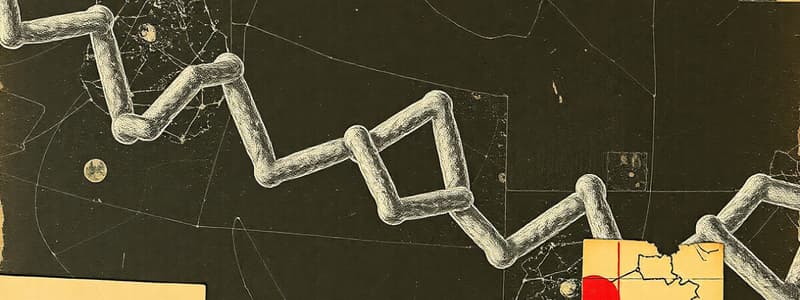Podcast
Questions and Answers
What are proteins composed of?
What are proteins composed of?
Unbranched polymers of amino acids linked head to tail.
The peptide bond forms between the carboxyl group of one amino acid and the amino group of another amino acid, resulting in the release of ______.
The peptide bond forms between the carboxyl group of one amino acid and the amino group of another amino acid, resulting in the release of ______.
H2O
Which of the following best describes the conformation of the peptide bond?
Which of the following best describes the conformation of the peptide bond?
- Flexible with free rotation
- Rigid and unable to rotate (correct)
- Only allows rotation about the Cα-Co bond
- Partially double-bonded (correct)
The polypeptide backbone is relatively reactive chemically.
The polypeptide backbone is relatively reactive chemically.
What is released during peptide bond formation?
What is released during peptide bond formation?
What does the term 'dipeptide' refer to?
What does the term 'dipeptide' refer to?
What are oligopeptides?
What are oligopeptides?
What is the role of disulfide bridges in heteromultimer proteins?
What is the role of disulfide bridges in heteromultimer proteins?
The peptide bond has approximately ______% double-bond character.
The peptide bond has approximately ______% double-bond character.
Which substance can reduce disulfide bridges to regenerate cysteine side chains?
Which substance can reduce disulfide bridges to regenerate cysteine side chains?
Flashcards are hidden until you start studying
Study Notes
Primary Structure of Proteins
- Proteins are unbranched polymers formed by amino acids (AAs) linked through covalent peptide bonds.
- Peptide formation involves an amide bond between the carboxyl group of one AA and the amino group of another, resulting in water release.
- The peptide backbone follows a repeated -N-Cα-Co sequence:
- N: Amide nitrogen
- Cα: α-carbon atom of the AA
- Co: Carbonyl carbon of the AA
- The carbonyl oxygen and amide hydrogen adopt a trans conformation to minimize steric hindrance.
Peptide Bond Characteristics
- Peptide bonds exhibit partial double-bond character, preventing free rotation around the bond.
- The bond has approximately 40% double-bond character due to resonance, contributing to its stability.
- The peptide backbone is relatively polar, featuring a positively charged amide nitrogen and a negatively charged carbonyl oxygen.
- The partial charges present create a permanent dipole, influencing the molecule's interactions.
Classification of Peptides
- Peptides are classified based on the number of amino acids:
- Dipeptides: 2 AAs
- Tripeptides: 3 AAs
- Tetrapeptides: 4 AAs
- Oligopeptides: 12 or more AAs
Polypeptide Chain Sequencing
- Separation of heteromultimer proteins into individual polypeptide chains is the first step in sequencing.
- Common dissociation methods include high pH, urea, guanidinium hydrochloride, or high salt concentrations, disrupting polar interactions.
- Intrachain disulfide bridges between cysteine residues must be cleaved if present.
- Identifying N-terminal and C-terminal residues is crucial to determine sequence orientation.
Disulfide Bridge Cleavage
- Interchain disulfide links must be broken before isolation of individual polypeptide chains.
- Oxidation of disulfides using performic acid results in cysteic acid, which is ionized and prevents recombination.
- Reducing agents like 2-mercaptoethanol or dithiothreitol (DTT) restore cysteine thiol groups (Cys-SH).
- Following reduction, alkylating agents (iodoacetate or 3-bromopropylamine) are used to prevent reformation of disulfide bridges.
Overall Process of Sequencing
- The entire procedure allows for determination of the amino acid sequence by generating overlapping peptide fragments for reconstruction.
- Repeated cleavage procedures facilitate the identification of complete amino acid sequences.
Studying That Suits You
Use AI to generate personalized quizzes and flashcards to suit your learning preferences.




